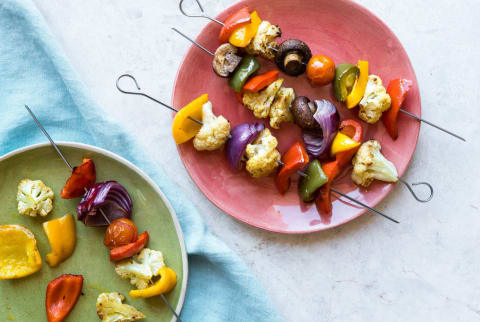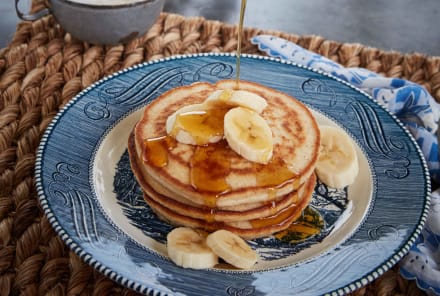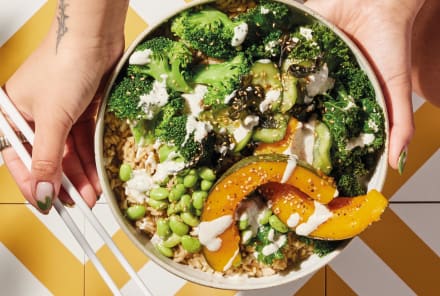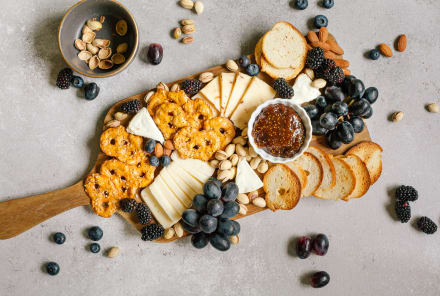Advertisement
These 10 Foods Actually Reverse Cellular Aging, According To Science


It’s possible to actually eat your way to longevity through a biological process called autophagy. The name comes from two Greek words—auto meaning "self" and phagy meaning "to eat." Essentially, autophagy means self-eating. While that might not sound very appealing, it is extremely beneficial. My simple explanation: Autophagy allows your cells to eat away damage, keeping you healthy. But as we get older, it becomes less efficient and damage accumulates. That buildup eventually slows down cell function and in turn can lead to a sluggish metabolism, decreased collagen and elastin production, and other diminished performance.
The good news—you can get your cells to self-cannibalize again! Yes, I know how odd that sounds, but it’s much easier and more enjoyable than you might think. All you have to do is eat! There are compounds in certain foods that aid in autophagy. And the best part: They are probably already in your kitchen! Here are my top 10 foods for looking and feeling way younger:
1. Chocolate
This autophagy-activating polyphenol regulates life span and your metabolism. It can also protect against free radical destruction, increase fat breakdown, and help stave off hunger. Look for chocolate with at least 70 percent "cocoa solids" on the label as these generally have more polyphenols than ones with lower percentages, according to a study in the Journal of Functional Foods.
2. Eggs
Eggs contain a compound called sphingolipids that aids in autophagy. Think of a brick wall. Sphingolipids are like mortar, the sticky substance that holds the bricks together. As the wall ages, the mortar can break down, causing the bricks to crumble and the entire structure to lose its strength. But you can keep your mortar strong by eating sphingolipid-rich foods. Doing so will benefit your skin, keeping it fuller, plumper, and smoother.
Sphingolipids also help regulate neurotransmitters, important in healthy brain function. Read: better moods, better decision-making, increased critical thinking, and improved memory.
3. Salmon
Rich in autophagy-boosting omega-3s, salmon can help suppress inflammation and stimulate self-eating in some cells. In addition, omega-3s have been shown1 to help improve heart health and serve an important role in protecting your brain cells.
My favorite is Alaskan wild salmon as it’s super high in omega-3s and tastes delicious. Plus, it’s easy to find canned versions in your local supermarket—just make sure to choose one that’s BPA-free.
4. Cauliflower
Cauliflower contains a sulfur-containing compound called sulforaphanes that initiate autophagy by turning up processes that degrade old, abnormal proteins. It also behaves as an antioxidant, blocking free radicals from causing damage to cells. In addition, this sulforaphane-rich food can boost autophagy in some cells in your eyes, helping with vision issues as you age. It is best to eat it raw because some of its nutritional content can leach into cooking water. But if you can’t tolerate raw cauliflower, try steaming it for just two or three minutes to ensure you get the maximum amount of nutrients.
5. Mango
Mangoes contain 122 milligrams of autophagy-activating vitamin C per fruit. They're also a potent source of zeaxanthin, an antioxidant that helps keep your eyes healthy by filtering out harmful blue light rays that contribute to macular degeneration. And if you can’t find fresh—or let’s be real, just don’t want to deal with the pain of peeling a mango!—frozen is just as healthy.
6. Beef
Where’s the vitamin D? Well, it’s in beef—and it’s helping to regulate your autophagy by improving the quality of cell-to-cell communication. Plus vitamin D is crucial in immune system regulation2. I suggest choosing grass-fed beef. In addition to the vitamin D, it has been found to be higher than grain-fed in precursors for vitamin E, also an aid for autophagy and a cancer-fighting antioxidant. Grass-fed options are also more likely to be free of hormones and antibiotics.
7. Avocado
Avocado is one of the best autophagy-promoting foods. This is because it is rich in vitamin E, vitamin K, and a great source of healthy fat. Vitamin E is an antioxidant that protects the body tissue from damage caused by free radicals. Vitamin K is an essential vitamin for health and plays an important role in blood clotting. Without vitamin K, blood would not clot. Some studies suggest that vitamin K also helps maintain strong bones in the elderly. And avocados are virtually the only fruit that contains monounsaturated fat, which is heart healthy and keeps you satiated.
In my book, Glow15, I’ve created a recipe for my favorite way to eat this autophagy-activating fruit. I call it AvocaGlow. Here is what you’ll need: 2 teaspoons tea seed oil, 1 teaspoon fresh lemon juice, sea salt, red pepper flakes, and of course: ½ an avocado. In a small bowl, whisk together the tea seed oil, lemon juice, salt, and red pepper flakes. Then just drizzle the mixture over the avocado and enjoy.
8. Cheese
Say cheese! Cheese is something you can smile about eating. It’s rich in spermidine, a natural polyamine found both in plants and in human cells. In humans, levels of spermidine decrease with age, which is important because they directly interact with DNA and turn on genes that regulate autophagy. A recent study3 showed that spermidine can help increase life span and reverse age-related cardiac problems, and it’s also been shown to help with memory.
As the name implies, the spermidine in cheese is also found in semen—but this isn't taking an R-rated turn. I suggest getting it through aged cheddar, as it has the highest levels of spermidine.
9. Legumes
Legumes are rich in saponins, plant chemicals that possess detergent qualities that foam when shaken in water. They activate autophagy by stimulating your immune system. Studies show they may also help lower your risk for high cholesterol and help you control your blood sugar. This is crucial to autophagy, as the presence of glucose triggers insulin secretion, which turns on genes that suppress autophagy.
Red wine also has saponins, so I like to pair my legumes with a glass of red Zinfandel, which has the highest amount of these phytochemicals. The alcohol content also appears to help your body absorb saponins.
10. Sauerkraut
Sauerkraut is rich in probiotics, beneficial strains of bacteria found in fermented foods. It can help with digestion by sending cellular signals that initiate autophagy and remove damage from your cells.
I like to ferment my own sauerkraut (for a full lesson on fermentation, check out this beginner's guide). Here is a recipe that you can also find in my book, Glow15: All you need is one cabbage, shredded in a food processor, and 1 tablespoon of sea salt. In a large bowl, mix the cabbage with salt. Use a large wooden spoon to pound the cabbage to release the juices, about 10 minutes. Cabbage should be very wet. Place cabbage in a wide-mouthed jar and press down firmly until the juices rise above the cabbage. The cabbage needs to be submerged in the liquid for proper fermentation to occur. You don’t want to grow mold. Cover tightly and keep at room temperature for three days. Then just transfer to the fridge and eat!
Watch Next
Enjoy some of our favorite clips from classes
Enjoy some of our favorite clips from classes
What Is Meditation?
Mindfulness/Spirituality | Light Watkins
Box Breathing
Mindfulness/Spirituality | Gwen Dittmar
What Breathwork Can Address
Mindfulness/Spirituality | Gwen Dittmar
The 8 Limbs of Yoga - What is Asana?
Yoga | Caley Alyssa
Two Standing Postures to Open Up Tight Hips
Yoga | Caley Alyssa
How Plants Can Optimize Athletic Performance
Nutrition | Rich Roll
What to Eat Before a Workout
Nutrition | Rich Roll
How Ayurveda Helps Us Navigate Modern Life
Nutrition | Sahara Rose
Messages About Love & Relationships
Love & Relationships | Esther Perel
Love Languages
Love & Relationships | Esther Perel











